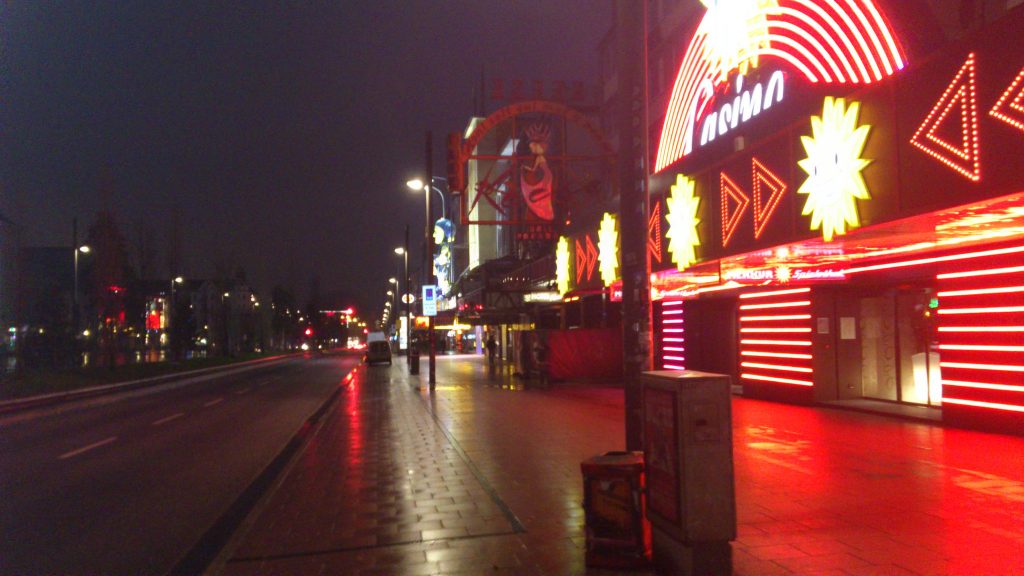St. Pauli – What’s up with this infamous German neighborhood? Posted by Sten on Nov 21, 2019 in Culture, Language
St. Pauli. You may have heard of this Stadtteil (district) in Hamburg. It is berüchtigt (infamous) and known all over Germany. But why? What’s so special about St. Pauli?
FC St. Pauli
The first reason is the Fußballverein (football club) FC St. Pauli that’s from this Stadtteil. While the name suggests that this is a Fußballverein only, it is much more. With 19 Abteilungen (divisions), FC St. Pauli has teams from Rugby (rugby) to Segeln (sailing) to Schach (chess). With 29,000 members, it is one of the largest Sportvereine (sport clubs) of Germany. And that’s about 7,000 people more than actually live in the Stadtteil St. Pauli!
And while that is not particularly extraordinary, the Fanszene (fan scene) of the club is. It identified itself as being politisch (political) from the start. From blocking Bauprojekte (construction projects) in their own Stadt (city) to confronting fans of rivaling football teams through (controversial) political statements, it has certainly contributed to the fame of St. Pauli.
Also, because the Sportplatz (playing field) is close to the Reeperbahn, the football players are sometimes also called Kiezkicker (Kiez kickers). Let’s talk about that Kiez.
Die Reeperbahn
Die Reeperbahn is the main street of the Vergnügungs- and Rotlichtviertel (amusement and red-light district) of Hamburg. There are Diskos (discos), Kneipen (bars) and clubs (clubs). The district is famous around the world, which is why sometimes, St. Pauli is used as a totum pro parte for the Reeperbahn.
But what does Reeperbahn even mean? Where does that name come from?
Reepe is an old word for Seil (rope – notice how Reepe and rope are similar!). Hamburg has always been a Hafenstadt (harbor city) and the Seile for the Schiffe (ships) were made by hand. A lot of space was required for this, and the inner city was too full. So the Reepschläger (ropemakers) took to the Hamburger Berg, as St. Pauli was known in the 17th century. The Querstraße (crossroad) Seilerstraße still reminds of this practice, too.
Later, this Reeperbahn street became the home of other people that were not welcome within the walls of the city. Prostituierte (prostitutes) and Glücksspieler (gamblers) made their way to St. Pauli, and that is how the modern-day Reeperbahn began.
And the name St. Pauli? The Viertel was first known as Hamburger Berg, but this would change in the 1830s. In 1831, the Bewohner (residents) received the full hamburger Bürgerrechte (Hamburg citizen rights). In 1833, the name was changed to St. Pauli, referring to the church by the same name in the Viertel. Only in 1894, the Vorort (suburb) officially became a Viertel of Hamburg.
And how did it earn the nickname Kiez? Kiez is Berlin slang for Viertel – but St. Pauli is in Hamburg. This actually goes back to a song from 1921, called Mignon vom Kiez by Friedrich Hollaender and Hermann Valentin. At the beginning of the 20th century, Kiez was used as a spöttischer (mocking) term for a Viertel, and since St. Pauli was home to rather unconventional people at the time, the term Kiez really established itself. Listen to a cover of Mignon vom Kiez here:
Do you wanna know more about it? A simple search will find you all kinds of stories. Such as this documentary:
Have you been to the Reeperbahn before? Is there a famous district like this in your country? Let me know in the comments below!

Build vocabulary, practice pronunciation, and more with Transparent Language Online. Available anytime, anywhere, on any device.





Comments:
Ian Mitchell:
I was often in the Reeperbahn in Hamburg, when I was a British Soldier in the British Sector of Germany, and afterwards with my wife, as a civilian living in Germany, 1963 – 1989. On the Reeperbahn, there is also the famous ‘Inspection 1’ (Police Station), after which a TV Series in Germany was named.